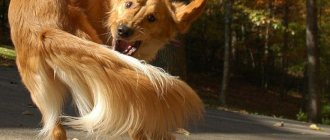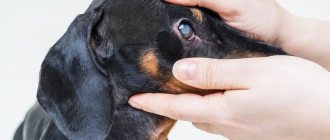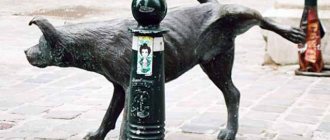Should you worry when your dog chews its tail?
If a puppy is playing with its tail, this is normal. This is how kids entertain themselves when they are bored.
To prevent such games from developing into a habit, the small pet needs to pay more attention. Then he won't feel lonely.
If an adult dog is chasing its tail, this is considered a deviation from normal behavior. When the situation continues for several days, accompanied by growling or whining, it is worth taking the animal to the veterinarian.
Such aggression towards one's own body may be a reaction to a serious health problem.
Erase data in storage
We will show you how to clean the Yandex Browser storage using an example.
In the list of settings, select “Advanced” and then “Clear history”.
A window will open with options designed to clear information related to using the browser. There is also a drop-down list that sets the time period for cleaning files. The following options are available:
- Remove in an hour
- Delete in a day
- Delete in a week
- Remove in 4 weeks
- Delete all time
Check the box next to “files saved in cache” and click the “clear history” button. If you don't want to accidentally reset other settings, be sure to check that the options next to them are disabled.
Reasons for strange behavior
When a dog rages at its tail, it is most likely trying to eliminate the cause of its discomfort.
The factor may be harmless, but this is not a reason to ignore the situation.
Foreign objects entangled in fur
During walks, pets often climb into the wilds, as a result, burrs, thorns, and dry branches cling to their tail.
The thicker the fur, the more small “souvenirs” the dog can grab. They are very annoying, so the dog tries to chew these objects out.
Presence of harmful insects
Ticks can cling to the tail, and fleas like to live there.
Parasites don't just cause discomfort: their bites are painful and make you want to scratch. Therefore, the animal frantically chews its tail.
Itching
An unpleasant sensation occurs both on the back and in the anus area. There are several reasons:
skin diseases;- food and other types of allergies;
- presence of helminths.
Each of the problems is accompanied by severe itching, forcing the dog to chew itself until it bleeds.
To correctly diagnose the prevailing factor, pay attention to the accompanying symptoms.
Signs of itching problems
The stronger the itching, the more restless the animal.
The pet does not eat well, does not get enough sleep, and is apathetic to games. All his time is occupied by the desire to scratch, so it is necessary to remove the irritant as quickly as possible.
| Cause | Symptoms |
| Allergy |
|
| Helminths |
|
| Skin diseases |
|
Tail injury
Damage to the vertebrae and soft tissue affects the nerve endings, causing severe pain. It is this that the dog tries to calm down, grabbing the tail with its teeth, which only intensifies the discomfort.
Sometimes strong sensations can be caused by improper docking of the tail: bone elements remain in the stump.
Inflammation of the paraanal glands
Their main function is to secrete a liquid with which the animal marks its territory. If there are problems with this organ, pets lose the desire to conquer space, so the enzymes stagnate in the gland and provoke inflammation.
This is manifested by the following symptoms:
the area around the anus becomes swollen and painful;- the wool in this place is thinning;
- there is redness and moisturizing of the skin;
- Sometimes a small rash or watery or pus-filled blisters appear.
Such signs make the pet irritable and sometimes aggressive.
Inflammation is often accompanied by fever and fever. If not treated promptly, the problem will lead to paralysis of the back of the torso .
Poor animal care
The sebaceous glands located in the tail area show increased activity due to the fact that the dog often wags its appendage.
If the owner ignores the rules of hygiene and rarely washes the pet, fat accumulations cause severe itching.
Physical inactivity
In pets that are not walked very often, blood stagnates due to an inactive lifestyle. Inflammatory processes can begin in any part of the body, and the tail is no exception.
Hormonal disbalance
The problem occurs in females during estrus. The release of estrogen causes compulsive behavior. The bitch not only chases the tail, but also bites non-existent insects, intensively licks her paws, etc.
Psychological factors
The described reasons are more related to the physical condition of the pet, but the problem can also be triggered by a psychological factor.
Change of residence, separation from the owner, the appearance of another animal in the house, etc.
– stressful situations to which the dog reacts inadequately. Pets are often frightened by the noise of household appliances, thunderclaps, and explosions of firecrackers.
Such surprises can cause a dog to grab its tail (like some people bite their nails to calm their nerves).
Help an animal
If the pet is bored and tries to attract attention. To eliminate a problem with a tail, it is enough to play with the dog so that the animal calms down.
If the problem is irritating factors, some of them can be eliminated yourself: remove foreign objects from the tail, wash your pet, review the dog’s diet and lifestyle.
In cases where health problems become the culprit, you cannot do without the help of a specialist.
Veterinarians examine the dog and choose treatment:
when insects are detected, insecticidal preparations are used;- Get rid of helminths by worming your pet;
- for skin diseases, allergies, inflammatory processes, appropriate therapy is selected;
- Tail injuries often require surgery.
Without establishing the true cause of strange behavior, help will be ineffective and will even worsen the problem. Incorrect therapy can put the animal into even greater stress.
Owners don’t know what to do if an animal gnaws its tail until it bleeds. Not every factor causes a pet to do this. But if the dog chews the tail before wounds appear, it is necessary to immediately treat the damage with an antiseptic.
The dog may show aggression, so first put a muzzle on it.
Game element
The most harmless reason for biting your tail is when your pet is trying to entertain itself. A puppy who finds himself in an apartment without his friends may get bored. He does not yet perceive the tail as part of the body and takes it for a moving toy that is interesting to catch.
If an adult pet is seen doing such an activity, perhaps the dog lacks communication with the owner and his affection. In an attempt to attract attention, she may, for example, bite her own tail instead of furniture.
If such behavior is not intrusive in nature, the animal is easily distracted from such an activity and switches to playing with its owners, then there is no reason to worry.
Strange behavior while eating
A pet may be distracted from food for one of the reasons described, causing discomfort in the tail (or under the influence of a psychological factor). Owners sometimes associate this behavior with food, but irritants such as smell and taste are more likely to cause muzzle scratching than tail scratching.
For the body to respond to foods, a certain time must pass after eating them. Due to poor quality food, your dog may develop skin dermatitis.
A large amount of sweets and baked goods in the diet provokes itching.
Due to an unbalanced diet, your pet may experience disruptions in the gastrointestinal tract. In some cases this manifests itself as constipation, in others – diarrhea.
In both situations, the anus is affected and the irritation often affects the base of the tail.
To ensure that your pet does not experience discomfort either during or after eating, you should carefully select the diet, relying on high-quality feed and food products.
Dependence of behavior on the season
The ambient temperature can also cause discomfort in the animal. In summer, dogs suffer from the heat, and long-haired breeds suffer the most. They sweat a lot, and this causes itching.
When it is not possible to scratch hard-to-reach places, the dog “acts out” on the tail. A light shower or bathing the animal in a pond helps to cope with the situation.
In winter, dogs that are outdoors have a cold tail, and this may be accompanied by pain.
To warm the “fifth limb”, it is necessary to disperse the blood, which the animal does by massaging the tail with its teeth.
If your pet lives in the yard, you should take care of insulating the booth. It is better to walk your pet dog in winter in special overalls.
Prevention
Itching causes great discomfort to the pet and interferes with normal life. It is quite difficult to establish the reason why a dog chews its back near its tail and cure this disease, so it is important to follow basic preventive measures that will minimally reduce the likelihood of the disease occurring.
- Watch your diet.
- Treat against parasites.
- Regularly inspect your dog's coat.
- Get examined by a veterinarian.
- Maintain hygiene.
You should not carry out water procedures too often; bathing your pet once a month is enough. Otherwise, a large amount of subcutaneous fat is lost, and this often leads to drying out of the skin and coat, causing itching on the dog’s body.
When to worry
If tail hunting occurs periodically, it is not particularly of concern to the dog owner. You should worry when the situation becomes protracted. Running in circles for a long time indicates an unstable mental state.
This behavior of a pet can unbalance the vestibular apparatus, which will worsen the general condition of the animal. Obsessive manifestations also lead to physical exhaustion.
When a pet continually and violently pulls at its appendage, it often ends in serious injury. As a result, the entire tail has to be amputated.
It is difficult to control such a situation: the owner cannot pay attention to the dog 24 hours a day. Therefore, prohibitions here are not effective, but will make the relationship with your pet strained.
Sedatives and antidepressants will help cope with psychological problems. Special training, games and meaningful walks will distract your dog from obsessive behavior.
It is recommended to switch your pet's attention from chasing the tail to the implementation of natural instincts. Fetching, playing with a frisbee, hunting or playfully chasing a mechanical hare would be appropriate here.
Symptoms when you need to visit a veterinarian
With catcher's syndrome, you need to clearly distinguish when your pet is just playing and when it's time to sound the alarm and go to the vet.
When to go to the vet:
- The dog constantly chews its tail and begins to bark and whine.
- The animal has difficulty breathing.
- Running continues for a long time.
- The pet has poor sleep and lack of appetite.
- Wounds, sores on the skin.
- Impaired movement coordination.
- Jaw clicking.
- The appearance of bald patches on the skin.
- Aggressive behavior without provoking factors.
- Aggressive behavior towards other pets with whom the dog was previously friends.
If your pet starts chasing its tail and does it very often, this is a reason to contact the veterinarian.
Sores in the tail area











